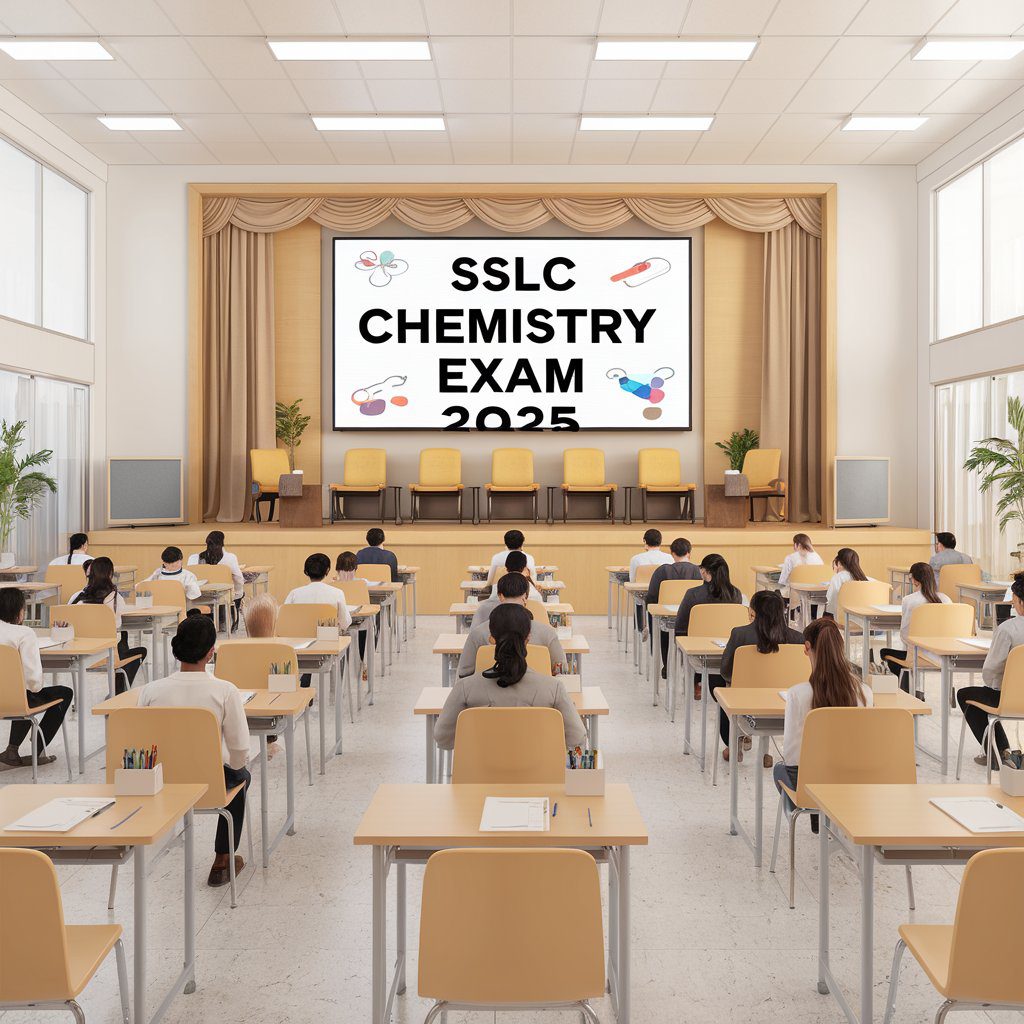SSLC Chemistry exam 2025 -Frequently asked questions..
- What is the date of the SSLC Chemistry exam for 2025?
- Answer: March 24, 2025.
- What is the duration of the SSLC Chemistry exam 2025?
- Answer: 2 hours and 15 minutes.
- What are the key topics covered in the SSLC Chemistry exam?
- Answer: Atomic Structure, Chemical Reactions, Acids and Bases, Periodic Classification.
- How can I download the SSLC Chemistry question paper for 2025?
- Answer: Visit the Kerala Pareeksha Bhavan website or educational websites like Careers360.
- What is the difficulty level of the SSLC Chemistry exam?
- Answer: Expected to be moderate to challenging.
- What are the types of questions in the SSLC Chemistry exam?
- Answer: Multiple Choice Questions (MCQs), Short Answer Questions (SAQs), Long Answer Questions (LAQs).
- How do I prepare for the SSLC Chemistry exam?
- Answer: Practice previous year papers, focus on key topics.
- What is the total mark for the SSLC Chemistry exam 2025?
- Answer: 40 marks for the written exam, plus 10 marks for Continuous Evaluation (CE).

- What is the role of pH indicators in chemistry?
- Answer: pH indicators change color in response to changes in pH.
- What is the concept of redox reactions?
- Answer: Reactions involving both oxidation and reduction.
- What are the main groups in the periodic table?
- Answer: Alkali metals, alkaline earth metals, halogens, and noble gases.
- What is electrolysis?
- Answer: The process of using electricity to split a compound into its elements.
- How do I calculate my expected score using the answer key?
- Answer: Match your answers with the answer key and calculate based on the marking scheme.
- What are the benefits of solving previous year question papers?
- Answer: Helps in understanding the exam pattern and improving time management.
- Can I get a scholarship for NEET/JEE coaching after passing the SSLC Chemistry exam?
- Answer: Yes, various scholarships are available.
- How do I stay updated with the latest SSLC Chemistry exam news?
- Answer: Follow educational websites and official announcements.
- What is the concept of valency?
- Answer: The number of electrons an atom can gain, lose, or share to form bonds.
- What are the types of chemical bonds?
- Answer: Ionic, covalent, and metallic bonds.
- What is the role of catalysts in chemical reactions?
- Answer: Catalysts speed up chemical reactions without being consumed.
- How do I manage stress during the SSLC Chemistry exam 2025?
- Answer: Stay calm, read questions carefully, and manage time effectively.
- What are the key concepts in atomic structure?
- Answer: Protons, neutrons, electrons, and atomic number.
- How do I improve my understanding of chemical reactions?
- Answer: Practice balancing chemical equations and understanding reaction types.
- What is the difference between a saturated and an unsaturated solution?
- Answer: A saturated solution contains the maximum amount of solute, while an unsaturated solution can dissolve more solute.
- What are the benefits of studying chemistry?
- Answer: Helps in understanding natural phenomena and developing problem-solving skills.
- How do I use the SSLC Chemistry exam answer key effectively?
- Answer: Match your answers with the key to identify areas for improvement.
- What are the common mistakes to avoid in the SSLC Chemistry exam 2025?
- Answer: Not reading questions carefully, not managing time effectively, and not revising key concepts.
- What is the law of conservation of mass?
- Answer: Matter cannot be created or destroyed in a chemical reaction.
- What is the difference between a mixture and a compound?
- Answer: A mixture can be separated into its components, while a compound cannot.
- What is the process of crystallization?
- Answer: The formation of crystals from a solution.
- What is the difference between a homogeneous and a heterogeneous mixture?
- Answer: Homogeneous mixtures have the same composition throughout, while heterogeneous mixtures do not.
- What is the concept of pH?
- Answer: A measure of how acidic or basic a solution is.
- How do I prepare for application-based questions in the SSLC Chemistry exam?
- Answer: Practice solving problems and focus on conceptual clarity.
- What is the difference between an acid and a base in terms of pH?
- Answer: Acids have a pH below 7, while bases have a pH above 7.
- What is the role of pH indicators in identifying acids and bases?
- Answer: pH indicators change color in response to changes in pH, helping to determine if a solution is acidic or basic.
- What are the types of chemical reactions?
- Answer: Synthesis, decomposition, displacement, and double displacement reactions.
- How do I calculate the number of moles of a substance?
- Answer: Use the formula: moles = mass / molar mass.
- What is the Avogadro’s number?
- Answer: 6.022 x 10^23 particles per mole.
- What is the difference between a physical change and a chemical change?
- Answer: Physical changes involve no change in chemical composition, while chemical changes involve a change in chemical composition.
- What is the process of oxidation?
- Answer: The loss of electrons by an atom, molecule, or ion.
- What is the process of reduction?
- Answer: The gain of electrons by an atom, molecule, or ion.
- What is the concept of redox reactions in terms of oxidation and reduction?
- Answer: Reactions involving both oxidation and reduction.
- How do I balance chemical equations?
- Answer: Ensure the number of atoms of each element is the same on both sides of the equation.
- What are the main groups in the periodic table and their characteristics?
- Answer: Alkali metals are highly reactive, alkaline earth metals are less reactive than alkali metals, halogens are highly reactive, and noble gases are unreactive.
- What is the concept of periodic classification of elements?
- Answer: Elements are arranged in the periodic table based on their atomic number and chemical properties.
- How do I identify the type of chemical bond in a compound?
- Answer: Ionic bonds involve the transfer of electrons, covalent bonds involve sharing of electrons, and metallic bonds involve free movement of electrons.
- What is the role of catalysts in speeding up chemical reactions?
- Answer: Catalysts lower the activation energy required for a reaction to occur.
- What are the benefits of studying chemistry for future careers?
- Answer: Helps in understanding natural phenomena and developing problem-solving skills, which are essential for careers in science and technology.
- How do I manage my time effectively during the SSLC Chemistry exam 2025?
- Answer: Prioritize questions based on difficulty and time required.
- What are the most challenging topics in the SSLC Chemistry exam?
- Answer: To be updated soon.
- How do I stay motivated while preparing for the SSLC Chemistry exam 2025?
- Answer: Set achievable goals, reward yourself for milestones achieved, and maintain a consistent study routine.
- What are the most challenging sections in the SSLC Chemistry exam 2025?
Answer:Based on the available information, the most challenging sections in the SSLC Chemistry exam 2025 were not explicitly detailed in the search results. However, here are some insights into the exam’s structure and difficulty level:
Assertion-Reasoning Section: This part of the exam required in-depth conceptual understanding, making it challenging for students who focused on memorization rather than understanding concepts1.
Numerical Problems: Some students struggled with numerical problems, indicating that these might have been more challenging for those who did not practice well1.
Application-Based Questions: These questions tested conceptual clarity, suggesting that students needed a strong grasp of concepts to answer them effectively3.
Overall, the exam was described as moderate in difficulty, with most questions being direct and syllabus-based3. However, specific challenging sections were not highlighted beyond these aspects.
Author
-

About the Author P. Hari Prasad is a highly experienced blogger and content writer with over 10 years of experience in crafting engaging, informative, and SEO-optimized articles. Holding a Master's degree in Chemistry (M.Sc Chemistry ), he brings a unique blend of scientific knowledge and creative storytelling to his work. With expertise in educational topics, career guidance, and technology trends, P. Hari Prasad has helped thousands of readers make informed decisions about their academic and professional journeys. His articles are meticulously researched, ensuring accuracy, relevance, and alignment with Google's E-E-A-T (Experience, Expertise, Authoritativeness, Trustworthiness) guidelines. P. Hari Prasad is passionate about empowering students and parents with actionable insights and practical advice. When he's not writing, you can find him exploring new developments in science and technology or mentoring young writers. For more insightful articles, stay tuned to his blog, where education meets inspiration. WordPress, Make Money Online, News and Technology through this website.
View all posts

